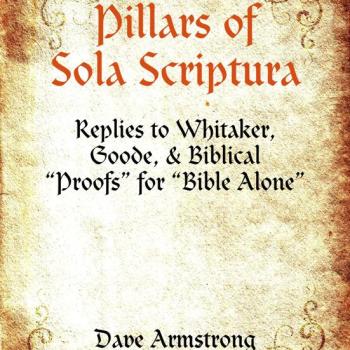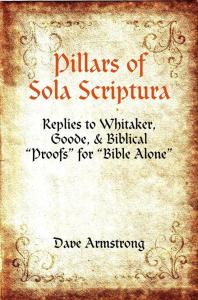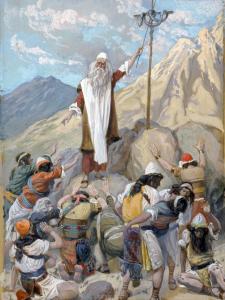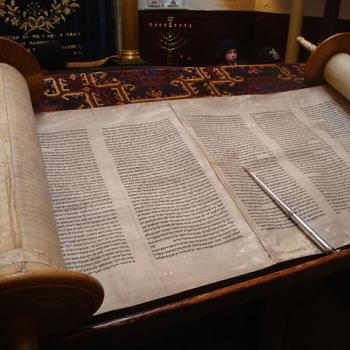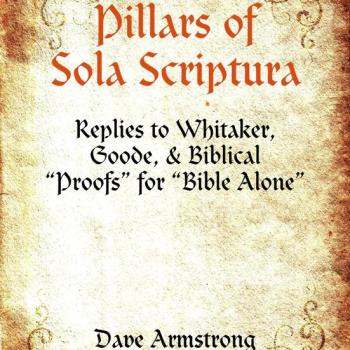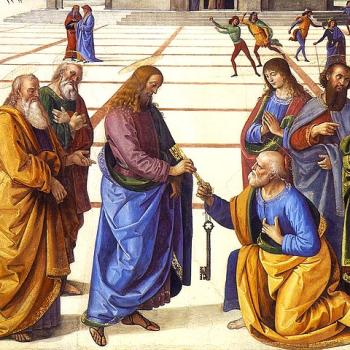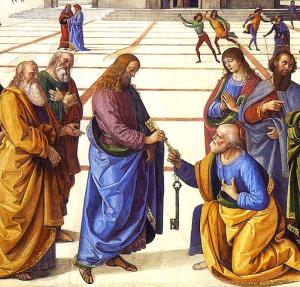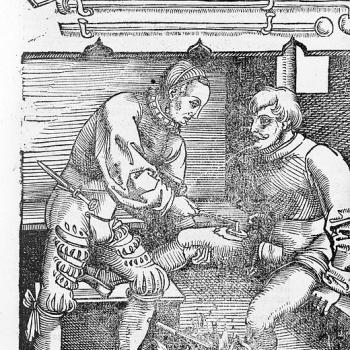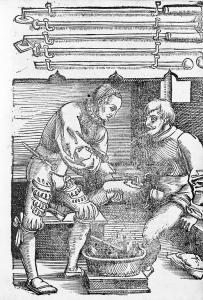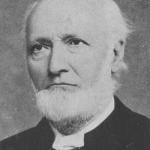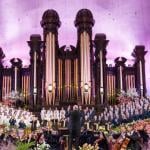Francisco Tourinho is a Brazilian Calvinist apologist. He described his theological credentials on my Facebook page:
I have the respect of the academic community for my articles published in peer review magazines, translation of unpublished classical works into Portuguese and also the production of a book in the year 2019 with more than 2000 copies sold (with no marketing). In addition I have higher education in physical education from Piauí State University and theology from the Assemblies of God Biblical Institute, am currently working towards a Masters from Covenant Baptist Theological Seminary, and did post-graduate work at Dom Bosco Catholic University. Also, I am a professor in the Reformed Scholasticism discipline at the Jonathan Edwards Seminary in the postgraduate course in Philosophical Theology. [edited slightly for more flowing English]
1) Stick solely to biblical arguments; exegesis, commentaries, systematic theology. Citing others is fine as long as it is on the biblical text or the doctrine being discussed.*2) Don’t mention Church history on either side, internal affairs and real or supposed scandals of the Catholic Church, denominations, etc.*3) Both of us should try to actually interact point-by-point rather than picking and choosing; a serious debate where all the opponent’s arguments are grappled with.*4) If the personal attacks start, the dialogue is immediately over. I can’t control what goes on on your Facebook page and network of buddies and fan club (and my Brazilian friends are pretty outspoken too!), but we can both control what goes into our written responses.
Justification, according to Catholicism, is a true eradication of sin, a supernatural infusion of grace, and a renewal of the inner man. [1] The Catholic Church holds that true faith in Jesus Christ is not saving faith unless it bears fruit in good works, without which spiritual growth is impossible. [2] In this way, good works are necessary for salvation, and sanctification is not separated from justification. Rather, the two are intrinsically intertwined, as with the Bible and Tradition. [3]
Sanctification is the process of being made actually holy, not merely legally declared so. [4] It begins at Baptism, [5] is facilitated by means of prayer, acts of charity and the aid of sacraments, and is consummated upon entrance to Heaven and union with God. [6] . . .
Catholicism holds that a person cannot save himself by his own self-originated works. This is Catholic dogma, and always has been, notwithstanding any distortions of it by nominal and undereducated Catholics, or ill-informed anti-Catholic polemicists. Nor is anyone saved or redeemed by Mary or a pope or anyone else besides our Lord and Savior Jesus Christ.
On this particular matter there is no difference whatsoever between Catholic and Protestant. [7] The doctrine of “works-salvation,” often wrongly attributed to Catholicism, is a heresy known as Pelagianism, which was in fact roundly condemned by St. Augustine (354-430), the above-mentioned Council in 529, and the Council of Trent (Canon I on Justification, January 13, 1547). [pp. 25-27]
FOOTNOTES
[1] Catechism of the Catholic Church (CCC), Liguori, Missouri: Liguori Publications, 1994, #1987-1992; Council of Trent, Decree on Justification (DJ), chapters 7-8 (January 13, 1547). All Trent citations are from Dogmatic Canons and Decrees, Rockford, Illinois: TAN Books & Publishers, 1977 (orig. 1912); John A. Hardon, Pocket Catholic Dictionary (PCD), New York: Doubleday Image, 1980, 214-215. [The late Servant of God Fr. John A. Hardon, S. J. — who knew me and received me into the Catholic Church — endorsed my book in its Foreword]
[2] CCC, #144-147, 2008-2009; Trent, DJ, chapters 11, 16; Hardon, PCD, 259.
[3] CCC, #1995; Trent, DJ, chapter 10, canons 24-26, 31.
[4] CCC, #1987, 1990, 2000.
[5] CCC, #1265-1266, 1987, 1992, 1997; Hardon, PCD, 39.
[6] CCC, #826, 1127, 1133, 2003, 2030, 2098; Hardon, PCD, 393.
[7] CCC, #613-614, 970, 2010-2011; Trent, DJ, chapters 5-6, canon 33. Previous citation from the 2nd Council of Orange (Canon 18) from Louis Bouyer, The Spirit and Forms of Protestantism, A. V. Littledale, trans. (London: Harvill Press, 1956), 68.
A) Grace is the ultimate enabling cause of faith and justification and salvation (sola gratia);*and*B) Good works are absolutely necessary and non-optional in the Christian life as the proof or inevitable fruit of the authenticity of a genuine faith.
Romans 8:13-17 (RSV) for if you live according to the flesh you will die, but if by the Spirit you put to death the deeds of the body you will live. [14] For all who are led by the Spirit of God are sons of God. [15] For you did not receive the spirit of slavery to fall back into fear, but you have received the spirit of sonship. When we cry, “Abba! Father!” [16] it is the Spirit himself bearing witness with our spirit that we are children of God, [17] and if children, then heirs, heirs of God and fellow heirs with Christ, provided we suffer with him in order that we may also be glorified with him.
1 Corinthians 9:27 but I pommel my body and subdue it, lest after preaching to others I myself should be disqualified.
1 Corinthians 10:12 Therefore let any one who thinks that he stands take heed lest he fall.
1 Corinthians 16:13 Be watchful, stand firm in your faith, be courageous, be strong.
2 Corinthians 1:24 . . . you stand firm in your faith.
2 Corinthians 13:5 Examine yourselves, to see whether you are holding to your faith. Test yourselves. Do you not realize that Jesus Christ is in you? — unless indeed you fail to meet the test!
Galatians 5:1 . . . stand fast therefore, and do not submit again to a yoke of slavery . . .
Philippians 2:12-13 Therefore, my beloved, as you have always obeyed, so now, not only as in my presence but much more in my absence, work out your own salvation with fear and trembling; for God is at work in you, both to will and to work for his good pleasure.
Philippians 3:11-14 that if possible I may attain the resurrection from the dead. [12] Not that I have already obtained this or am already perfect; but I press on to make it my own, because Christ Jesus has made me his own. [13] Brethren, I do not consider that I have made it my own; but one thing I do, forgetting what lies behind and straining forward to what lies ahead, [14] I press on toward the goal for the prize of the upward call of God in Christ Jesus.
Philippians 4:1 . . . stand firm thus in the Lord . . .
Colossians 1:22-23 he has now reconciled in his body of flesh by his death, in order to present you holy and blameless and irreproachable before him, [23] provided that you continue in the faith, stable and steadfast, not shifting from the hope of the gospel which you heard, . . .
1 Timothy 4:16 Take heed to yourself and to your teaching: hold to that, for by so doing you will save . . . yourself . . .
*
How many good works will I have to do to be considered righteous before God?
1 Samuel 28:16, 18 And Samuel said, “. . . the LORD has turned from you and become your enemy . . . [18] [b]ecause you did not obey the voice of the LORD, and did not carry out his fierce wrath against Am’alek . . .
2 Kings 22:13 (cf. 2 Chr 34:21) “. . . the wrath of the LORD that is kindled against us, because our fathers have not obeyed the words of this book, to do according to all that is written concerning us.”
Psalm 7:8-10 The LORD judges the peoples; judge me, O LORD, according to my righteousness and according to the integrity that is in me. O let the evil of the wicked come to an end, but establish thou the righteous, thou who triest the minds and hearts, thou righteous God. My shield is with God, who saves the upright in heart.
Psalm 58:11 Men will say, “Surely there is a reward for the righteous; surely there is a God who judges on earth.”
Ecclesiastes 12:14 For God will bring every deed into judgment, with every secret thing, whether good or evil.
Isaiah 59:18 According to their deeds, so will he repay, wrath to his adversaries, requital to his enemies; . . .
Jeremiah 4:4 (cf. 21:12) Circumcise yourselves to the LORD, remove the foreskin of your hearts, O men of Judah and inhabitants of Jerusalem; lest my wrath go forth like fire, and burn with none to quench it, because of the evil of your doings.”
Ezekiel 7:3 (cf. 7:8; 33:20) Now the end is upon you, and I will let loose my anger upon you, and will judge you according to your ways; and I will punish you for all your abominations.
Ezekiel 36:19 I scattered them among the nations, and they were dispersed through the countries; in accordance with their conduct and their deeds I judged them.
Micah 5:15 And in anger and wrath I will execute vengeance upon the nations that did not obey.
Zephaniah 2:3 Seek the LORD, all you humble of the land, who do his commands; seek righteousness, seek humility; perhaps you may be hidden on the day of the wrath of the LORD.
Matthew 5:22 But I say to you that every one who is angry with his brother shall be liable to judgment; whoever insults his brother shall be liable to the council, and whoever says, `You fool!’ shall be liable to the hell of fire.
Matthew 7:16-27 You will know them by their fruits. Are grapes gathered from thorns, or figs from thistles? So every sound tree bears good fruit; but the bad tree bears evil fruit. A sound tree cannot bear evil fruit, nor can a bad tree bear good fruit. Every tree that does not bear good fruit is cut down and thrown into the fire. Thus you will know them by their fruits. Not every one who says to me, “Lord, Lord,” shall enter the kingdom of heaven, but he who does the will of my Father who is in heaven. On that day many will say to me, “Lord, Lord, did we not prophesy in your name, and cast out demons in your name, and do many mighty works in your name?” And then will I declare to them, “I never knew you; depart from me, you evildoers.” Every one then who hears these words of mine, and does them will be like a wise man who built his house upon the rock; and the rain fell, and the floods came, and the winds blew and beat upon that house, but it did not fall, because it had been founded on the rock. And every one who hears these words of mine, and does not do them will be like a foolish man who built his house upon the sand; and the rain fell, and the floods came, and the winds blew and beat against that house, and it fell; and great was the fall of it.
Matthew 10:22 (cf. Mt 24:13; Mk 13:13) . . . But he who endures to the end will be saved.
Matthew 16:27 For the Son of man is to come with his angels in the glory of his Father, and then he will repay every man for what he has done.
Matthew 18:8-9 (cf. Mk 9:43; 9:47) And if your hand or your foot causes you to sin, cut it off and throw it away; it is better for you to enter life maimed or lame than with two hands or two feet to be thrown into the eternal fire. And if your eye causes you to sin, pluck it out and throw it away; it is better for you to enter life with one eye than with two eyes to be thrown into the hell of fire.
Matthew 25:14-30 “For it will be as when a man going on a journey called his servants and entrusted to them his property; to one he gave five talents, to another two, to another one, to each according to his ability. Then he went away. He who had received the five talents went at once and traded with them; and he made five talents more. So also, he who had the two talents made two talents more. But he who had received the one talent went and dug in the ground and hid his master’s money. Now after a long time the master of those servants came and settled accounts with them. And he who had received the five talents came forward, bringing five talents more, saying, ‘Master, you delivered to me five talents; here I have made five talents more.’ His master said to him, `Well done, good and faithful servant; you have been faithful over a little, I will set you over much; enter into the joy of your master.’ And he also who had the two talents came forward, saying, `Master, you delivered to me two talents; here I have made two talents more.’ His master said to him, `Well done, good and faithful servant; you have been faithful over a little, I will set you over much; enter into the joy of your master.’ He also who had received the one talent came forward, saying, `Master, I knew you to be a hard man, reaping where you did not sow, and gathering where you did not winnow; so I was afraid, and I went and hid your talent in the ground. Here you have what is yours.’ But his master answered him, `You wicked and slothful servant! You knew that I reap where I have not sowed, and gather where I have not winnowed? Then you ought to have invested my money with the bankers, and at my coming I should have received what was my own with interest. So take the talent from him, and give it to him who has the ten talents. For to every one who has will more be given, and he will have abundance; but from him who has not, even what he has will be taken away. And cast the worthless servant into the outer darkness; there men will weep and gnash their teeth.’
Matthew 25:31-46 “When the Son of man comes in his glory, and all the angels with him, then he will sit on his glorious throne. Before him will be gathered all the nations, and he will separate them one from another as a shepherd separates the sheep from the goats, and he will place the sheep at his right hand, but the goats at the left. Then the King will say to those at his right hand, `Come, O blessed of my Father, inherit the kingdom prepared for you from the foundation of the world; for I was hungry and you gave me food, I was thirsty and you gave me drink, I was a stranger and you welcomed me, I was naked and you clothed me, I was sick and you visited me, I was in prison and you came to me.’ Then the righteous will answer him, `Lord, when did we see thee hungry and feed thee, or thirsty and give thee drink? And when did we see thee a stranger and welcome thee, or naked and clothe thee? And when did we see thee sick or in prison and visit thee?’ And the King will answer them, `Truly, I say to you, as you did it to one of the least of these my brethren, you did it to me.’ Then he will say to those at his left hand, `Depart from me, you cursed, into the eternal fire prepared for the devil and his angels; for I was hungry and you gave me no food, I was thirsty and you gave me no drink, I was a stranger and you did not welcome me, naked and you did not clothe me, sick and in prison and you did not visit me.’ Then they also will answer, `Lord, when did we see thee hungry or thirsty or a stranger or naked or sick or in prison, and did not minister to thee?’ Then he will answer them, `Truly, I say to you, as you did it not to one of the least of these, you did it not to me.’ And they will go away into eternal punishment, but the righteous into eternal life.”
Luke 3:9 (+ Mt 3:10; 7:19) Even now the axe is laid to the root of the trees; every tree therefore that does not bear good fruit is cut down and thrown into the fire.
Luke 14:13-14 But when you give a feast, invite the poor, the maimed, the lame, the blind, and you will be blessed, because they cannot repay you. You will be repaid at the resurrection of the just.
Luke 21:34-36 “But take heed to yourselves lest your hearts be weighed down with dissipation and drunkenness and cares of this life, and that day come upon you suddenly like a snare; for it will come upon all who dwell upon the face of the whole earth. But watch at all times, praying that you may have strength to escape all these things that will take place, and to stand before the Son of man.
John 5:26-29 For as the Father has life in himself, so he has granted the Son also to have life in himself, and has given him authority to execute judgment, because he is the Son of man. Do not marvel at this; for the hour is coming when all who are in the tombs will hear his voice and come forth, those who have done good, to the resurrection of life, and those who have done evil, to the resurrection of judgment.
Romans 1:18 For the wrath of God is revealed from heaven against all ungodliness and wickedness of men who by their wickedness suppress the truth.
Romans 2:5-13 But by your hard and impenitent heart you are storing up wrath for yourself on the day of wrath when God’s righteous judgment will be revealed. For he will render to every man according to his works: To those who by patience in well-doing seek for glory and honour and immortality, he will give eternal life; but for those who are factious and do not obey the truth, but obey wickedness, there will be wrath and fury. There will be tribulation and distress for every human being who does evil, the Jew first and also the Greek, but glory and honour and peace for every one who does good, the Jew first and also the Greek. For God shows no partiality. All who have sinned without the law will also perish without the law, and all who have sinned under the law will be judged by the law. For it is not the hearers of the law who are righteous before God, but the doers of the law who will be justified.
1 Corinthians 3:8-9 He who plants and he who waters are equal, and each shall receive his wages according to his labor. For we are God’s fellow workers; you are God’s field, God’s building.
2 Corinthians 5:10 For we must all appear before the judgment seat of Christ, so that each one may receive good or evil, according to what he has done in the body.
1 Thessalonians 3:12-13 . . . may the Lord make you increase and abound in love to one another and to all men, as we do to you, so that he may establish your hearts unblamable in holiness before our God and Father, at the coming of our Lord Jesus with all his saints.
1 Thessalonians 5:23 May the God of peace himself sanctify you wholly; and may your spirit and soul and body be kept sound and blameless at the coming of our Lord Jesus Christ.
2 Thessalonians 1:7-12 . . . when the Lord Jesus is revealed from heaven with his mighty angels in flaming fire, inflicting vengeance upon those who do not know God and upon those who do not obey the gospel of our Lord Jesus. They shall suffer the punishment of eternal destruction and exclusion from the presence of the Lord and from the glory of his might, when he comes on that day to be glorified in his saints, and to be marveled at in all who have believed, because our testimony to you was believed. To this end we always pray for you, that our God may make you worthy of his call, and may fulfil every good resolve and work of faith by his power, so that the name of our Lord Jesus may be glorified in you, and you in him, according to the grace of our God and the Lord Jesus Christ.
Hebrews 6:7-8 For land which has drunk the rain that often falls upon it, and brings forth vegetation useful to those for whose sake it is cultivated, receives a blessing from God. But if it bears thorns and thistles, it is worthless and near to being cursed; its end is to be burned.
1 Peter 1:17 . . . who judges each one impartially according to his deeds . . .
1 Peter 4:13 (cf. Rom 8:17) But rejoice in so far as you share Christ’s sufferings, that you may also rejoice and be glad when his glory is revealed.
2 Peter 3:10-14 But the day of the Lord will come like a thief, and then the heavens will pass away with a loud noise, and the elements will be dissolved with fire, and the earth and the works that are upon it will be burned up. Since all these things are thus to be dissolved, what sort of persons ought you to be in lives of holiness and godliness, waiting for and hastening the coming of the day of God, because of which the heavens will be kindled and dissolved, and the elements will melt with fire! But according to his promise we wait for new heavens and a new earth in which righteousness dwells. Therefore, beloved, since you wait for these, be zealous to be found by him without spot or blemish, and at peace.
Jude 6-16 And the angels that did not keep their own position but left their proper dwelling have been kept by him in eternal chains in the nether gloom until the judgment of the great day; just as Sodom and Gomor’rah and the surrounding cities, which likewise acted immorally and indulged in unnatural lust, serve as an example by undergoing a punishment of eternal fire. Yet in like manner these men in their dreamings defile the flesh, reject authority, and revile the glorious ones. But when the archangel Michael, contending with the devil, disputed about the body of Moses, he did not presume to pronounce a reviling judgment upon him, but said, “The Lord rebuke you.” But these men revile whatever they do not understand, and by those things that they know by instinct as irrational animals do, they are destroyed. Woe to them! For they walk in the way of Cain, and abandon themselves for the sake of gain to Balaam’s error, and perish in Korah’s rebellion. These are blemishes on your love feasts, as they boldly carouse together, looking after themselves; waterless clouds, carried along by winds; fruitless trees in late autumn, twice dead, uprooted; wild waves of the sea, casting up the foam of their own shame; wandering stars for whom the nether gloom of darkness has been reserved for ever. It was of these also that Enoch in the seventh generation from Adam prophesied, saying, “Behold, the Lord came with his holy myriads, to execute judgment on all, and to convict all the ungodly of all their deeds of ungodliness which they have committed in such an ungodly way, and of all the harsh things which ungodly sinners have spoken against him.” These are grumblers, malcontents, following their own passions, loud-mouthed boasters, flattering people to gain advantage.
Jude 20-21 But you, beloved, build yourselves up on your most holy faith; pray in the Holy Spirit; keep yourselves in the love of God; wait for the mercy of our Lord Jesus Christ unto eternal life.
Revelation 2:5 Remember then from what you have fallen, repent and do the works you did at first. If not, I will come to you and remove your lampstand from its place, unless you repent.
Revelation 2:23 . . . I am he who searches mind and heart, and I will give to each of you as your works deserve.
Revelation 20:11-13 Then I saw a great white throne and him who sat upon it; from his presence earth and sky fled away, and no place was found for them. And I saw the dead, great and small, standing before the throne, and books were opened. Also another book was opened, which is the book of life. And the dead were judged by what was written in the books, by what they had done. And the sea gave up the dead in it, Death and Hades gave up the dead in them, and all were judged by what they had done.
Revelation 21:8 But as for the cowardly, the faithless, the polluted, as for murderers, fornicators, sorcerers, idolaters, and all liars, their lot shall be in the lake that burns with fire and sulphur, which is the second death.
Revelation 22:12 Behold, I am coming soon, bringing my recompense, to repay every one for what he has done.
Therefore, in light of this survey of biblical statements on the topic, how would we properly, biblically answer the unbiblical, sloganistic question of certain evangelical Protestants?: “If you were to die tonight and God asked you why He should let you into heaven, what would you tell Him?” Our answer to his question could incorporate any one or all of the following 50 responses: all drawn from the Bible, all about works and righteousness, with only one that mentions faith at all, but not faith alone (#42):
1) I am characterized by righteousness.
2) I have integrity.
3) I’m not wicked.
4) I’m upright in heart.
5) I’ve done good deeds.
6) I have good ways.
7) I’m not committing abominations.
8) I have good conduct.
9) I’m not angry with my brother.
10) I’m not insulting my brother.
11) I’m not calling someone a fool.
12) I have good fruits.
13) I do the will of God.
14) I hear Jesus’ words and do them.
15) I endured to the end.
16) I fed the hungry.
17) I provided drink to the thirsty.
18) I clothed the naked.
19) I welcomed strangers.
20) I visited the sick.
21) I visited prisoners.
22) I invited the poor and the maimed to my feast.
23) I’m not weighed down with dissipation.
24) I’m not weighed down with drunkenness.
25) I’m not weighed down with the cares of this life.
26) I’m not ungodly.
27) I don’t suppress the truth.
28) I’ve done good works.
29) I obeyed the truth.
30) I’m not doing evil.
31) I have been a “doer of the law.”
32) I’ve been a good laborer and fellow worker with God.
33) I’m unblamable in holiness.
34) I’ve been wholly sanctified.
35) My spirit and soul and body aresound and blameless.
36) I know God.
37) I’ve obeyed the gospel.
38) I’ve shared Christ’s sufferings.
39) I’m without spot or blemish.
40) I’ve repented.
41) I’m not a coward.
42) I’m not faithless.
43) I’m not polluted.
44) I’m not a murderer.
45) I’m not a fornicator.
46) I’m not a sorcerer.
47) I’m not an idolater.
48) I’m not a liar.
49) I invited the lame to my feast.
50) I invited the blind to my feast.
St. James will say that “For whoever keeps the whole law and stumbles in one point is guilty of all. For whoever breaks one commandment of the law is guilty of breaking them all.” Tg [James] 2.10. When will I be righteous if one small sin makes me guilty of all? How many virtues do I have to develop? The truth is, if so, only those who reach absolute perfection can have peace with God; therefore, no one has peace with God. Who can say, “I am perfect before God”?
James 2:10 has to be interpreted and understood in light of related verses (cross-referencing and systematic theology). The Bible does not teach that all sins are absolutely equal. This is easy to prove. Francisco (and habitually, Protestants) go by one pet verse or a few highly selected, favored verses that appear at first glance (but not after deep analysis) to support their position. Catholics incorporate and follow the teachings of the Bible as a whole, and do not ignore dozens of passages because they go against preconceived positions (as Protestants so often do).
James 2:10 deals with man’s inability to keep the entire Law of God: a common theme in Scripture. James accepts differences in degrees of sin and righteousness elsewhere in the same letter: “we who teach shall be judged with a greater strictness” (3:1). In 1:12, the man who endures trial will receive a “crown of life.” In James 1:15 he states that “sin when it is full-grown brings forth death”.
Therefore, there must be sins that are not full-grown and do not bring about spiritual death. James also teaches that the “prayer of a righteous man has great power in its effects” (5:16), which implies that there are relatively more righteous people, whom God honors more, by making their prayers more effective (he used the prophet Elijah as an example). If there is a lesser and greater righteousness, then there are lesser and greater sins also, because to be less righteous is to be more sinful, and vice versa.
Righteousness doesn’t derive from the law. It comes from God and His enabling grace, not written words on a page, however good and true they are. Galatians 3:21 states “if a law had been given which could make alive, then righteousness would indeed be by the law” (cf. 2:16-17,21; 5:4-6,14,18; Rom 3:21-22; 4:13; 9:30-32). Paul writes in Romans 10:3: “For, being ignorant of the righteousness that comes from God, and seeking to establish their own, they did not submit to God’s righteousness.”
John Calvin teaches something quite different from the Bible, when he addresses James 2:10:
Even were it possible for us to perform works absolutely pure, yet one sin is sufficient to efface and extinguish all remembrance of former righteousness, as the prophet says (Ezek. 18:24). With this James agrees, “Whosoever shall keep the whole law, and yet offend in one point, is guilty of all,” (James 2:10). And since this mortal life is never entirely free from the taint of sin, whatever righteousness we could acquire would ever and anon be corrupted, overwhelmed, and destroyed, by subsequent sins, so that it could not stand the scrutiny of God, or be imputed to us for righteousness. (Institutes III, 14:10)
But the rule with regard to unrighteousness is very different. The adulterer or the thief is by one act guilty of death, because he offends against the majesty of God. The blunder of these arguers of ours lies here: they attend not to the words of James, “Whosoever shall keep the whole law, and yet offend in one point, he is guilty of all. For he that said, Do not commit adultery, said also, Do not kill,” &c. (James 2:10, 11). Therefore, it should not seem absurd when we say that death is the just recompense of every sin, because each sin merits the just indignation and vengeance of God. (Institutes III, 18:10)
It’s quite easy in context to see the error he commits with regard to Ezekiel 18. He states his interpretation of Ezekiel 18:24 as, “yet one sin is sufficient to efface and extinguish all remembrance of former righteousness.” But the prophet does not say any such thing! He is speaking generally and broadly of the sinners’ life vs. the life of the redeemed, righteous man. The verse (first part) states: “But when a righteous man turns away from his righteousness and commits iniquity and does the same abominable things that the wicked man does, shall he live?”
Notice that the sins are plural: not one little sin that supposedly undoes everything, as in Calvin’s schema. Ezekiel is teaching, in effect: “if you live in sin as the wicked and evil people do, you will [spiritually] die.” This is referring to people who give themselves totally over to sin (including mortal sins). These are what separate a person from God, not one white lie or lustful thought or stealing a cookie from the cookie jar.
Context makes this interpretation rather clear and obvious:
Ezekiel 18:5-13 If a man is righteous and does what is lawful and right — [6] if he does not eat upon the mountains or lift up his eyes to the idols of the house of Israel, does not defile his neighbor’s wife or approach a woman in her time of impurity, [7] does not oppress any one, but restores to the debtor his pledge, commits no robbery, gives his bread to the hungry and covers the naked with a garment, [8] does not lend at interest or take any increase, withholds his hand from iniquity, executes true justice between man and man, [9] walks in my statutes, and is careful to observe my ordinances — he is righteous, he shall surely live, says the Lord GOD. [10] If he begets a son who is a robber, a shedder of blood, [11] who does none of these duties, but eats upon the mountains, defiles his neighbor’s wife, [12] oppresses the poor and needy, commits robbery, does not restore the pledge, lifts up his eyes to the idols, commits abomination, [13] lends at interest, and takes increase; shall he then live? He shall not live. He has done all these abominable things; he shall surely die; his blood shall be upon himself.
The prophet continues in the same vein in 18:14-23. This is not Calvin’s “one sin”; it’s a host of sins, a lifestyle: a life given over to wanton wickedness and unrighteousness. Then in 18:26 he reiterates: “When a righteous man turns away from his righteousness and commits iniquity, he shall die for it; for the iniquity which he has committed he shall die.” If that weren’t clear enough, he refers again to “all the transgressions” (18:28, 31) and “all your transgressions” (18:30).
Again, he is plainly not talking about merely one sin, however small, but rather, a commitment to give oneself over to sin. We know this from the context, because the meaning is spelled out very clearly, in the greatest detail. But it’s easy to jerk one verse out of context and pretend that it means something different. Calvin, from a Catholic perspective, incorrectly exegetes Scripture in order to bolster up a false tenet in his theology.
He does the same with James 2:10: “For whoever keeps the whole law but fails in one point has become guilty of all of it.” The fallacy here is the equation of keeping the law with all attempts to be moral and righteous whatever. The two are not identical. If they were, Paul would not have contrasted the law and grace, as he often does (e.g., Rom 5:20; 6:14-15; Gal 2:21; 5:4; cf. Jn 1:17). Calvin understands this distinction full well and teaches it himself. It’s elementary New Testament soteriology. Yet when it suits his purpose, all of that knowledge gets tossed out the window, and he engages in sophistry and eisegetes one verse to try to prove a false doctrine. This won’t do. One must be both consistent and honest in the interpretation of the Bible.
Here are passages that show the differences in seriousness of sins (i.e., some of them — mortal sins — can cause one to lose their good graces with God and even justification and/or salvation, while others — venial sins — do not do so):
1 John 5:16-17 If any one sees his brother committing what is not a mortal sin, he will ask, and God will give him life for those whose sin is not mortal. There is sin which is mortal; I do not say that one is to pray for that. [17] All wrongdoing is sin, but there is sin which is not mortal.
1 John 5:16-17 expressly contradicts Protestant teaching on this. Protestants say (in stark contradiction of this passage) that “all sin leads to spiritual death,” and that all sins are equal in God’s eyes. Who am I to believe? The Apostle John is clearly making the distinctions we make with regard to degrees of sin (mortal vs. venial).
John 19:11 . . . he who delivered me to you has the greater sin.
People are not always completely aware that certain acts or thoughts are sinful. In Catholic and biblical theology, in order to commit a grave, or mortal sin, where one ceases to be in a state of grace and is literally in potential, but real danger of hellfire, three requirements are necessary: 1) it must be a very serious matter, 2) the sinner has to have sufficiently reflected on, or had adequate knowledge of the sin, and 3) he must have fully consented in his will. Scripture provides many indications of this difference in seriousness of sin, and in subjective guiltiness for it:
Numbers 15:27-31 If one person sins unwittingly, he shall offer a female goat a year old for a sin offering. [28] And the priest shall make atonement before the LORD for the person who commits an error, when he sins unwittingly, to make atonement for him; and he shall be forgiven. [29] You shall have one law for him who does anything unwittingly, for him who is native among the people of Israel, and for the stranger who sojourns among them. [30] But the person who does anything with a high hand, whether he is native or a sojourner, reviles the LORD, and that person shall be cut off from among his people. [31] Because he has despised the word of the LORD, and has broken his commandment, that person shall be utterly cut off; his iniquity shall be upon him.
Ezekiel 45:20 You shall do the same on the seventh day of the month for any one who has sinned through error or ignorance; so you shall make atonement for the temple. (cf. Rom 10:3; 1 Tim 1:13; 1 Pet 1:14)
Luke 12:47-48 And that servant who knew his master’s will, but did not make ready or act according to his will, shall receive a severe beating. But he who did not know, and did what deserved a beating, shall receive a light beating. Every one to whom much is given, of him will much be required; and of him to whom men commit much they will demand the more. (cf. Lev. 5:17, Lk. 23:34)
Luke 23:34 And Jesus said, “Father, forgive them; for they know not what they do.” . . .
John 9:41 Jesus said to them, “If you were blind, you would have no guilt; but now that you say, ‘We see,’ your guilt remains.”
Acts 3:17 And now, brethren, I know that you acted in ignorance, as did also your rulers.
Acts 17:30 The times of ignorance God overlooked, but now he commands all men everywhere to repent, (cf. Rom. 3:25)
1 Timothy 1:13 though I formerly blasphemed and persecuted and insulted him; but I received mercy because I had acted ignorantly in unbelief.
Hebrews 10:26 For if we sin deliberately after receiving the knowledge of the truth, there no longer remains a sacrifice for sins,
1 Peter 1:14 As obedient children, do not be conformed to the passions of your former ignorance,
Many other passages express the same notions, referring to sins committed “unwittingly” (Lev 4:2, 13, 22, 27; Lev 5:15, 18; 22:14; Num 15:24; Josh 20:3, 5; Tobit 3:3) which are “forgiven” (Lev 4:20, 26, 31, 35; 5:10, 16, 18; Num 15:25-26) through the usual processes of priestly sacrifice and atonement, based on the Law of Moses.
Lastly, there are several lists of sins that are said to bar one from heaven or “the kingdom of God”:
1 Corinthians 6:9-10 Do you not know that the unrighteous will not inherit the kingdom of God? Do not be deceived; neither the immoral, nor idolaters, nor adulterers, nor sexual perverts, [10] nor thieves, nor the greedy, nor drunkards, nor revilers, nor robbers will inherit the kingdom of God.
Galatians 5:19-21 Now the works of the flesh are plain: fornication, impurity, licentiousness, [20] idolatry, sorcery, enmity, strife, jealousy, anger, selfishness, dissension, party spirit, [21] envy, drunkenness, carousing, and the like. I warn you, as I warned you before, that those who do such things shall not inherit the kingdom of God.
Ephesians 5:5 Be sure of this, that no fornicator or impure man, or one who is covetous (that is, an idolater), has any inheritance in the kingdom of Christ and of God.
Revelation 21:8 But as for the cowardly, the faithless, the polluted, as for murderers, fornicators, sorcerers, idolaters, and all liars, their lot shall be in the lake that burns with fire and sulphur, which is the second death.
Revelation 22:14-15 Blessed are those who wash their robes, that they may have the right to the tree of life and that they may enter the city by the gates. [15] Outside are the dogs and sorcerers and fornicators and murderers and idolaters, and every one who loves and practices falsehood.
Thus, by immediate and undeniable implication, there are other lesser sins that do not do so.
In initial justification, as we call it, this is true. This is more common ground. It can’t be brought about by any work, because it is grace-originated, and God-originated (monergistic at this stage: to use a favorite Reformed term). But this is only the first stage.
Sincerely, I would like this distinction to become clearer and more precise: what does initial justification consist of? What is the second step? Are they two justifications or are they different views of the same justification?
Fernand Prat, S. J., a renowned biblical exegete and theologian, wrote:
Let us now return to Paul’s own declarations. That of the Epistle to the Romans is the simplest: ‘Man is justified by faith without the works of the Law.’ The requirement of the argument as well as the order of the sentence makes the emphasis fall on the last words of the statement which resolves itself into two propositions: ‘Man is justified without the works of the Law, independently of them’ — the principal proposition; ‘Man is justified by faith’ — an incidental proposition. It will be remarked that the Apostle here is not concerned with the part which works play after justification. They they are then necessary appears from his system of morals, and that they increase the justice already acquired follows from his principles; but in the controversy with the Judaizers the debate turns chiefly on first justification — namely, on the passage from the state of sin to that of grace. The works of the Law are neither the cause nor the essential condition, nor even, in themselves, the occasion of it; and according to the most elementary principles of the Pauline theology one could say as much of natural works done before justification, and with more reason. But note well that St. Paul does not say that faith is the only disposition required, and we know by other passages that it must be accompanied by two complementary sentiments: repentance for the past and acceptance of the divine will for the future. (The Theology of St. Paul, translated by John L. Stoddard, Westminster, Maryland: The Newman Bookshop, 1952, vol. 1 of 2, 175-176, bolded and italicized emphasis added in one place: “first”. Note that his phrase “first justification” is precisely synonymous with “initial justification.”)
John A. Hardon, S. J., uses similar terminology:
Adults are justified for the first time either by personal faith, sorrow for sin and baptism, or by the perfect love of God, which is at least an implicit baptism of desire. (Modern Catholic Dictionary, Garden City, New York: Doubleday & Co., 1980, “Justification, Theology of,” 302, italics added)
The “second step” is that grace-produced and “grace-soaked” good works become necessary alongside grace-produced and “grace-soaked” faith (see massive indications of that in my copious Scripture citations above).
The Catechism of the Catholic Church concurs:
2027 No one can merit the initial grace which is at the origin of conversion. . . . [my emphasis]
1987 The grace of the Holy Spirit has the power to justify us, that is, to cleanse us from our sins and to communicate to us “the righteousness of God through faith in Jesus Christ” and through Baptism: . . .
1989 The first work of the grace of the Holy Spirit is conversion, effecting justification in accordance with Jesus’ proclamation at the beginning of the Gospel: “Repent, for the kingdom of heaven is at hand.” Moved by grace, man turns toward God and away from sin, thus accepting forgiveness and righteousness from on high. . . . [my emphasis]
1996 Our justification comes from the grace of God. Grace is favor, the free and undeserved help that God gives us to respond to his call to become children of God, adoptive sons, partakers of the divine nature and of eternal life.
1998 This vocation to eternal life is supernatural. It depends entirely on God’s gratuitous initiative, for he alone can reveal and give himself. It surpasses the power of human intellect and will, as that of every other creature. [my emphasis]
1999 The grace of Christ is the gratuitous gift that God makes to us of his own life, infused by the Holy Spirit into our soul to heal it of sin and to sanctify it. . . .
2001 The preparation of man for the reception of grace is already a work of grace. This latter is needed to arouse and sustain our collaboration in justification through faith, and in sanctification through charity. God brings to completion in us what he has begun, . . .
2008 The merit of man before God in the Christian life arises from the fact that God has freely chosen to associate man with the work of his grace. The fatherly action of God is first on his own initiative, and then follows man’s free acting through his collaboration, so that the merit of good works is to be attributed in the first place to the grace of God, then to the faithful. Man’s merit, moreover, itself is due to God, for his good actions proceed in Christ, from the predispositions and assistance given by the Holy Spirit. [my emphasis]
2022 The divine initiative in the work of grace precedes, prepares, and elicits the free response of man. Grace responds to the deepest yearnings of human freedom, calls freedom to cooperate with it, and perfects freedom. [my emphases]
Grace comes first, causing conversion. Man is “moved by grace.” At that point it is monergistic. Since most Catholics are baptized as infants, insofar as the infant is concerned, this justification and regeneration is completely monergistic: an action of God alone (cf. #1992, 2020). One could say others are standing in for the child — I believe that Reformed would agree — , but that is scarcely different from a Protestant praying that someone would be “saved / justified” — God uses human beings somewhere in the process.
The terminology of men “earning salvation” is false if by it we mean Pelagianism or works-salvation. But it’s true in terms of cooperative merit. God gives us the grace to participate and work together with Him. Merit is God crowning His own gifts, as Augustine says. He wants us to participate in the thing, but it is all by grace and never without it.
Entirely biblical . . .
Catholic convert Kenneth Howell even maintained in a penetrating, helpful article, that Trent didn’t utterly exclude imputation.
In the following segment we begin the biblical debate on the topic of Justification. I defended our confession based on the text of Romans 3:28 “We conclude therefore that a man is justified by faith apart from the works of the law”.
Francisco then cites me at length, with regard to the phrase “works of the law” and how those Protestants who interpret it according to the “New perspective on Paul” view it.
The objection raised by Mr. Armstrong is unsuccessful because of the clear flaws of the New Perspective in Paul (NPP). Just for the sake of curiosity, Cornelius Lapide, at the time of the Reformation, also proposed the same distinction between works of the law and works that were not of the law, already being answered in his time.
Nothing new under the sun . . . Protestants are just now figuring out what Lapide knew 500 years ago. You’re slow, but at least some of you get it eventually. That’s good news! St. Augustine understood this, too, in AD 412, in his work, On the Spirit and the Letter:
For the Gentiles, which followed not after righteousness, have attained to righteousness, even the righteousness which is by faith, (Rom 9:30) — by obtaining it of God, not by assuming it of themselves. But Israel, which followed after the law of righteousness, has not attained to the law of righteousness. And why? Because they sought it not by faith, but as it were by works (Rom 9:31-32) — in other words, working it out as it were by themselves, not believing that it is God who works within them. For it is God which works in us both to will and to do of His own good pleasure. (Philippians 2:13) And hereby they stumbled at the stumbling-stone. (Rom 9:32) For what he said, not by faith, but as it were by works, (Rom 9:32) he most clearly explained in the following words: “They, being ignorant of God’s righteousness, and going about to establish their own righteousness, have not submitted themselves unto the righteousness of God. For Christ is the end of the law for righteousness to every one that believes.” (Rom 10:3-4) Then are we still in doubt what are those works of the law by which a man is not justified, if he believes them to be his own works, as it were, without the help and gift of God, which is by the faith of Jesus Christ? And do we suppose that they are circumcision and the other like ordinances, because some such things in other passages are read concerning these sacramental rites too? In this place, however, it is certainly not circumcision which they wanted to establish as their own righteousness, because God established this by prescribing it Himself. Nor is it possible for us to understand this statement, of those works concerning which the Lord says to them, You reject the commandment of God, that you may keep your own tradition; (Mark 7:9) because, as the apostle says, Israel, which followed after the law of righteousness, has not attained to the law of righteousness. (Rom 9:31) He did not say, Which followed after their own traditions, framing them and relying on them. This then is the sole distinction, that the very precept, “You shall not covet,” (Ex 20:17) and God’s other good and holy commandments, they attributed to themselves; whereas, that man may keep them, God must work in him through faith in Jesus Christ, who is the end of the law for righteousness to every one that believes. (Rom 10:4) That is to say, every one who is incorporated into Him and made a member of His body, is able, by His giving the increase within, to work righteousness. It is of such a man’s works that Christ Himself has said, “Without me you can do nothing.” (John 15:5) (chapter 50)
See much more about St. Augustine’s views on “works of the law” in Bryan Cross’ article, “St. Augustine on Law and Grace” (Called to Communion, 7-16-10).
Mr. Armstrong’s opinion seems to make it clear that justification is also by works, works other than works of law such as Dietetic Laws, Circumcision, and Observance of Special Days.
It’s not my opinion; it is the biblical teaching (see my 50 proofs of that above). But we agree on initial justification, as I have now made abundantly clear.
I disagree with Rev Wright’s interpretation for several reasons:
1 – The text does not deal only with Jews, but with all humanity, since it says that:
Romans 3:26-31 [I have posted RSV] it was to prove at the present time that he himself is righteous and that he justifies him who has faith in Jesus. [27] Then what becomes of our boasting? It is excluded. On what principle? On the principle of works? No, but on the principle of faith. [28] For we hold that a man is justified by faith apart from works of law. [29] Or is God the God of Jews only? Is he not the God of Gentiles also? Yes, of Gentiles also, [30] since God is one; and he will justify the circumcised on the ground of their faith and the uncircumcised through their faith. [31] Do we then overthrow the law by this faith? By no means! On the contrary, we uphold the law.
Paul is here talking about initial justification, which is by grace and faith. The fact that he expands it to all of humanity does not wipe out the meaning of the works of law: which are the Jewish marks of identity. He couldn’t possibly mean all works (assuming the Bible is self-consistent and inspired) since many other times he extolls good works. Again, the Catholic takes all relevant passages into consideration, not just a few carefully selected ones that appear to support their position (but in fact do not, upon close inspection, as I am doing here). Here is St. Paul using works in an exemplary sense, and even tying them to salvation itself:
Romans 2:6-10 For he will render to every man according to his works: [7] to those who by patience in well-doing seek for glory and honor and immortality, he will give eternal life; [8] but for those who are factious and do not obey the truth, but obey wickedness, there will be wrath and fury. [9] There will be tribulation and distress for every human being who does evil, the Jew first and also the Greek, [10] but glory and honor and peace for every one who does good, the Jew first and also the Greek.
2 Corinthians 5:10 For we must all appear before the judgment seat of Christ, so that each one may receive good or evil, according to what he has done in the body.
1 Thessalonians 3:12-13 . . . may the Lord make you increase and abound in love to one another and to all men, as we do to you, so that he may establish your hearts unblamable in holiness before our God and Father, at the coming of our Lord Jesus with all his saints.
2 Thessalonians 1:7-12 . . . when the Lord Jesus is revealed from heaven with his mighty angels in flaming fire, inflicting vengeance upon those who do not know God and upon those who do not obey the gospel of our Lord Jesus. They shall suffer the punishment of eternal destruction and exclusion from the presence of the Lord and from the glory of his might, when he comes on that day to be glorified in his saints, and to be marveled at in all who have believed, because our testimony to you was believed. To this end we always pray for you, that our God may make you worthy of his call, and may fulfil every good resolve and work of faith by his power, so that the name of our Lord Jesus may be glorified in you, and you in him, according to the grace of our God and the Lord Jesus Christ.
The text does not deal only with Jews, but with all men. All have sinned and come short of the glory of God. Why did everyone sin? For all have broken the law, for where there is no law there can be no transgression (Rom 4:15), and if there is no law today, then there is no sin either. Where there is sin, there is law. If there is sin today, it is because there is also law. The law lives on, judging everyone who does not believe in Christ. The law encompasses every good work, not only the observance of ceremonial or civil laws (dietary, circumcision and observance of special days), but mainly the moral law contained in the 10 Commandments. The moral law is of a natural nature and cannot be abolished. Paul certainly included the moral law among the works that could not justify—that is, all good works are included.
His last five words are an impossible conclusion due to the above passages in Paul, which hold that good works are essential, even unto salvation. I don’t believe the inspired Bible contradicts itself. Francisco, on the other hand, seems to have a low view of the Bible, so that it can contradict (hardly harmonious with the view that it is inspired / “God-breathed”). If not, then he needs to explain the four Pauline passages I produced above, and indeed all fifty related verses that I have brought forth.
Roman Catholic theology tends to make this interpretation that the text of the Letter to the Romans deals only with works of the law, but not with the “works of hope, fear and love”, which faith generates and produces, and which are under the faith as daughters under one mother, which is why they love the text of Galatians 5:6 so much. But St. Paul himself also calls these works works of the law: “Owe no man anything, except to love one another; because whoever loves others has fulfilled the law.” (Romans 13:8) For: Thou shalt not commit adultery, Thou shalt not kill, Thou shalt not steal, Thou shalt not bear false witness, Thou shalt not covet; and if there be any other commandment, it is all summed up in this word: Thou shalt love thy neighbor as thyself. Love does not harm others. So the fulfillment of the law is love. Romans 13:9,10
Romans 2:6-10 in and of itself decisively refutes this interpretation. “Roman Catholic theology” didn’t invent these notions. The Bible and particularly Paul did so. We merely follow their inspired guidance.
I believe that the heart of the matter has not been presented. Why are NPP’s and Mr. Armstrong’s objections unsuccessful? The answer lies in a point I already emphasized in the previous article: the objectivity and universality of justification found in Christ and justification by faith as justification by Christ-of-faith, which the NPP and Roman Catholics seem to be almost completely unaware of. The crucial point, in turn, is that, for Reformed Christians, the objectivity and universality of the extension of Christ’s work for the justification of the world requires that He Himself be present in the faith that receives justification. So “justification by faith alone” is not “justification by faith” in the sense that faith is an abstract saving entity. Faith is saving, but only as it aims at Christ, not by a power inherent in itself. Just as the Father can be called a savior, but not in the sense that Christ is. A person can have true faith in Allah and not be justified, because it is the object of faith that justifies, rather than faith itself. But if the object of our faith is Christ, and Christ has perfect righteousness, then in receiving him we also have perfect righteousness, and are therefore fully justified. No good works can merit Christ upon us, not even faith can merit Christ, for God does not justify us by the fact that we have faith, as if faith were the formal cause of justification, Christians do not become worthy of justification by having faith. , but we are accounted righteous on the basis of the righteousness of Christ which is imputed to us through faith. Faith is an instrumental cause only, not a formal cause of justification. Faith is like a pot full of gold, where the gold is Christ, surely the man who obtains the pot does not become rich by the pot, but by the treasure he carries.
Yes: all that is true of initial justification. But that justification can be lost. Of course, Reformed theology denies that it can ever be lost, once possessed by God’s express decree (“perseverance of the saints”: the “P” in “TULIP”; also “unconditional election” and “irresistible grace”: all of which I have refuted many times with copiously biblical argumentation). This is another grossly unbiblical doctrine that I have partially refuted above (and can produce many more passages that refute it, and devoted large portions in one of my books to this task). And in order to maintain initial justification, one must cooperate with this same grace and do good works. I’ve already shown that in my many Bible passages, while Francisco gives us just a few, wrongly interpreted and isolated from others on the same topic. That’s both lousy exegesis (indeed, it is eisegesis), and bad (or nonexistent) systematic theology. But, E for effort . . .
How are the Jews in this case? The central point that Paul deals with is the Jews’ disbelief in justification by Christ alone. They did not believe that Jesus was the Covenant par excellence. They did not believe that Jesus was Israel par excellence, they did not want to be justified by Christ alone. Something besides Christ was needed, which is why Paul speaks of the works of the law.
Exactly. These were portions of the Law by which some (many?) Jews thought granted them salvation. It’s a technical and specifically Jewish meaning, not a broad meaning extended to al good works whatsoever. If the latter notion is held, some hundred or more clear Bible verses have to be explained other than the way I and Catholics have interpreted them.
There is not even mention of a debate between works of the law and works that are not of the law, for the fulcrum was not this, but that Paul admonished them that nothing more was needed to be justified than faith! Paul means that Christ is sufficient.
It wouldn’t have crossed Paul’s mind to condemn all works as having any connection to salvation, since this is such a clear and constant teaching of Scripture, and his own teaching (my 50 passages plus more . . .). He need not mention a thing that he casually assumed any Christian with even minimal understanding already accepts as a truism (good works are necessary in the Christian life and for salvation: always in conjunction with grace and faith).
We have PEACE with God through faith in Christ Jesus (Rom 5:1). St. Paul affirms that there is no self-righteousness in his person, but the righteousness of Christ which comes by faith: And indeed I count all things loss for the excellency of the knowledge of Christ Jesus my Lord; for which I have suffered the loss of all these things, and count them as dross, that I may gain Christ, and be found in him, not having a righteousness of my own that comes from the law, but that which comes through faith in Christ, namely, righteousness that comes from God by faith; Philippians 3:8,9.
None of that is in dispute. It applies to initial justification. Francisco can’t prevail in this debate simply by repeating Protestant (Reformed) talking points over and over. He will eventually have to grapple with my scores and scores of biblical passages brought to bear — i.e., opposing arguments — , and explain how they all fit into Protestant theology. He agreed to a biblical debate. I have given him tons of Bible to mull over and interpret according to his theological views. It’s my specialty in my apologetics. I have given him many more Bible passages in this installment, so that he truly has his work cut out for him, in having to abide by Debate Terms #3 (“Both of us should try to actually interact point-by-point rather than picking and choosing; a serious debate where all the opponent’s arguments are grappled with”).
But the greatest proof that Paul is speaking of all any work in the text of Romans 3:28 comes from Mr Armstrong’s own interpretation when he says:
James 2:24 You see that a man is justified by works and not by faith alone.
The phrase “faith alone” appears exactly once in the RSV: in this verse. Justification by “faith alone” is expressly denied! This is one of three times (along with James 2:21 and 2:25 further below) that the Bible also expresses the notion of “justified by works” (in context, along with faith). Four other passages in James directly, expressly contradict “faith alone” but with different words:
James 2:14 What does it profit, my brethren, if a man says he has faith but has not works? Can his faith save him?
James 2:17 So faith by itself, if it has no works, is dead.
James 2:20 Do you want to be shown, you shallow man, that faith apart from works is barren?
James 2:26 For as the body apart from the spirit is dead, so faith apart from works is dead.
I don’t see how, but let’s hear Francisco out . . .
Follow the reasoning: according to Mr. Armstrong, St. James is teaching that works justify as long as they are not works of the law,
That’s not exactly my reasoning, which is that post-initial justification works originated by God in grace and cooperated with by a believer, are intrinsically part of faith, and that both together justify and sanctify. I put it all together in one of my books (Revelation!: 1001 Bible Answers to Theological Questions: 2013; verses KJV unless noted otherwise):
Salvation is Ultimately by Grace Alone
Where does it state that we are saved by grace alone?
2 Timothy 1:9 who saved us and called us with a holy calling, not in virtue of our works but in virtue of his own purpose and the grace which he gave us in Christ Jesus ages ago,
Are we justified by grace?
Romans 3:24 they are justified by his grace as a gift, through the redemption which is in Christ Jesus,
Are we called by grace?
Galatians 1:15 But when he who had set me apart before I was born, and had called me through his grace,
Does justification come through grace rather than law?
Galatians 2:21 I do not nullify the grace of God; for if justification were through the law, then Christ died to no purpose.
Salvation is Not by Faith Alone
Where is the Protestant notion of faith alone (sola fide) denied?
James 2:22, 24 You see that faith was active along with his works, and faith was completed by works,… [24] You see that a man is justified by works and not by faith alone.
Are works, in conjunction with faith, said to be necessary for salvation?
Romans 2:13 For it is not the hearers of the law who are righteous before God, but the doers of the law who will be justified.
Is faith alone described as insufficient for salvation?
James 2:14 What does it profit, my brethren, if a man says he has faith but has not works? Can his faith save him?
Do we actually “work out” our salvation?
Philippians 2:12-13 Therefore, my beloved, as you have always obeyed, so now, not only as in my presence but much more in my absence, work out your own salvation with fear and trembling; [13] for God is at work in you, both to will and to work for his good pleasure.
Can we deny God and our faith in Him, by our deeds?
Titus 1:16 They profess to know God, but they deny him by their deeds; they are detestable, disobedient, unfit for any good deed.
Do we have to obey Jesus, as well as have faith in Him, to be saved?
John 3:36 He who believes in the Son has eternal life; he who does not obey the Son shall not see life, but the wrath of God rests upon him.
Is something more required for salvation than believing in and calling on Jesus’ name?
Matthew 7:21 Not every one who says to me, “Lord, Lord,” shall enter the kingdom of heaven, but he who does the will of my Father who is in heaven.
Can we deceive ourselves by hearing the gospel message of salvation only, and not being “doers” of it?
James 1:22 But be doers of the word, and not hearers only, deceiving yourselves.
Is obedience to Jesus directly tied to salvation (even without mentioning faith)?
Hebrews 5:9 and being made perfect he became the source of eternal salvation to all who obey him,
Salvation is Not by Works Alone (Pelagianism)
Where is it expressly stated that our works cannot save us?
Ephesians 2:8-10 For by grace you have been saved through faith; and this is not your own doing, it is the gift of God — [9] not because of works, lest any man should boast. [10] For we are his workmanship, created in Christ Jesus for good works, which God prepared beforehand, that we should walk in them. (cf. 2 Tim 1:9 above)
Is grace shown to be in contradistinction to works, in terms of salvation?
Romans 11:5-6 So too at the present time there is a remnant, chosen by grace. [6] But if it is by grace, it is no longer on the basis of works; otherwise grace would no longer be grace.
Grace + Faith + Works + Obedience = Salvation
Are grace, faith, and obedience ever linked together in one passage?
Romans 1:5 through whom we have received grace and apostleship to bring about the obedience of faith for the sake of his name among all the nations,
Is obedience to the gospel important, as well as belief in the gospel?
Romans 10:16 But they have not all obeyed the gospel; . . .
Are faith and obedience aligned?
Romans 16:26 but is now disclosed and through the prophetic writings is made known to all nations, according to the command of the eternal God, to bring about the obedience of faith —
Is there such a thing as a “work of faith”?
1 Thessalonians 1:3 remembering before our God and Father your work of faith and labor of love and steadfastness of hope in our Lord Jesus Christ.
because Mr. Armstrong denies that the works of the law can justify, since this was his defense to say that the text of Rom 3:28 did not teach justification by faith alone and the antithesis created by St. Paul was in relation to the works of the law that did not justify.
That’s correct. That is a technical meaning used by Paul, with a specific application to the Jews who sought to abide by the Mosaic Law.
The problem is that St. James was also talking about works of the law, for he says: For whoever obeys the whole law, but stumbles in one of its ordinances, is guilty of breaking it in its entirety. (James 2.10).
I’ve already dealt with James 2:10 at great length and in considerable depth, so I need not revisit that. But that is a question of observance of the whole law, not a belief that abiding by particular portions of it could bring about salvation. Thus, “apples and oranges . . .”
But it doesn’t end here. Saint Paul, after speaking about the relationship between justification by faith and works in Romans chapter 3, continues his argument in chapter 4, in which he quotes Abraham (Based on Genesis 15:6) as someone who was justified without works, but only by faith. Mr. Armstrong then remarks that these works were works of the law, not good works that are not of the law:
Paul uses the example of Abraham in Romans 4, in emphasizing faith, over against the Jewish works of circumcision as a supposed means of faith and justification (hence, he mentions circumcision in 4:9-12, and salvation to the Gentiles as well as Jews in 4:13-18). But this passage, too, goes back to the issue of “the works of the law.”
Francisco skipped over the very next portion, where I explained what I meant, by means of a citation of a Facebook friend of mine, “Adomnan.”
However, Mr. Armstrong, when interpreting the text of James, who is also interpreting the Abrahamic case, changes the speech:
James 2:20-26 also refers back to Genesis 15:6, and gives an explicit interpretation of the Old Testament passage, by stating, “and the scripture was fulfilled which says, . . .” (2:23). The previous three verses were all about justification, faith, and works, all tied in together, and this is what James says “fulfilled” Genesis 15:6. The next verse then condemns Protestant soteriology by disagreeing the notion of “faith alone” in the clearest way imaginable.
In the first moment, when dealing with the text of Rom 3.38 and Rom 4.5 that deal with the justification of Abraham, he says: Or, paraphrasing all Romans 4:5: “And to Abraham, before he had done any work of the Torah, but still believed in the One who regards the Gentiles as righteous, his belief was credited as an act of righteousness.” (quoting Adomnan.)
Here Francisco is desperately (and alas, unsuccessfully) trying to catch me in a self-contradiction, rather than interacting point-by-point with my given reasoning, which violates #3 of our Debate Terms. My argumentation was completely consistent. He hasn’t shown otherwise, and has ignored a key clarifying point, save for one passing reference.
That is, the text of Genesis 15.6, in the opinion of Mr. Armstrong, means that Abraham was not justified by the works of the Torah.
Of course not. That was the whole point of it: that he was a forerunner of justification by faith. But much more importantly: Abraham was not under Mosaic Law in the first place, since he lived several hundred years before Moses. Thus, my arguments about “works of the law” are utterly extraneous to anything concerning Abraham and his exercised faith. Francisco seems to overlook this super-relevant fact. In order to be bound to the law of Moses and “works of the law” therein, the Law of Moses had to first exist. And it didn’t in Abraham’s time.
But, curiously, according to the same Mr. Armstrong, St. James did not see works of the Torah in the text of Genesis 15.6, because according to Mr. Armstrong, St. James speaks of works that are not of the law and that justify. Mr. Armstrong will have to decide if the text referring to the justification of Abraham (Gen 15.6 quoted by Saint James and Saint Paul) deals with works of the Torah (which do not justify) or if they do not deal with works of the Torah (which justify), because contradicts itself in its interpretation.
Again, Genesis 15:6 can’t have anything to do with “works of the [Mosaic] law” (which is the Catholic and NPP view) because the Mosaic Law did not yet exist. Romans 4:3, 5, referring to Abraham (Gen 15:6) was Abraham’s second justification: “. . . ‘Abraham believed God, and it was reckoned to him as righteousness.’ . . . [5] And to one who does not work but trusts him who justifies the ungodly, his faith is reckoned as righteousness.” As Jimmy Akin argued (cited by me), he had also been spoken as having been justified in Genesis 12:1-4, when he was obedient to God’s instruction and left Haran.
We know this because Hebrews 11:8 states that Abraham had faith “when he was called to go out to the place he would afterward receive”. So that had to be justification by faith, according to Protestant belief. But then James 2 refers to a third justification of Abraham when he was willing to sacrifice Isaac:
James 2:21-24 Was not Abraham our father justified by works, when he offered his son Isaac upon the altar? [22] You see that faith was active along with his works, and faith was completed by works, [23] and the scripture was fulfilled which says, “Abraham believed God, and it was reckoned to him as righteousness”; and he was called the friend of God. [24] You see that a man is justified by works and not by faith alone.
So we have Abraham being justified at least three times, according to the Bible. So much for the Protestant one-time justification that (in the Calvinist brand of soteriology) can never be lost, either. But none of my reference to Abraham (or that of James) has anything to do with the “works of the law” controversy. James never uses the phrase “works of the law” in his entire book. Nor does Paul in Romans 4, when he refers back to Abraham. So this entire line of reasoning from Francisco is null and void; a non sequitur.
In conclusion: when Mr. Armstrong addresses the text of Abraham in the letter to the Romans, he says that Paul said that Abraham was not justified by the works of the law.
Well, he wasn’t, because he was never under the Law. But that wasn’t the statement I made, which was, rather: “But this passage, too, goes back to the issue of ‘the works of the law.'” In other words, I was simply noting that the text had relevance in the overall discussion; not that it had to do with that particular issue. Francisco misunderstood that (which is easy to do in a complex discussion), and so his reply went off into an irrelevant direction. But I appreciate the opportunity that mistake of his gave me to further clarify for all readers: especially Protestant ones.
Then he said that St. James correctly interpreted this text.
Yes, so did Paul (it being inspired revelation in both cases).
But, according to Mr. Armstrong himself, St. James does not regard those works as works of the law.
Nor does Paul. The entire point about Abraham is that he was justified by faith: but at least three times: not once, as Protestants hold must have been the case. They have a huge problem in explaining this threefold justification of Abraham.
Mr. Armstrong uses the Abraham text quoted by Saint Paul to say that what was being referred to there are works of the law, and that Paul militated against the works of the Torah
I did not, as I have now explained. Francisco simply misunderstood my meaning. So he’s been “barking up the wrong tree” [an English idiom] all this time; meanwhile, he has not offered a plausible alternative to my actual argument.
and at the same time uses the interpretation of James that deals with the same text about Abraham to say that these good works are works that justify because they are not works of the law.
It’s not what I did at all, as explained.
***
With all the citing of Francisco’s words and my own (tedious but necessary as a great learning tool in the back-and-forth dialogue), I’m over 15,000 words at this point (about 52 pages, single-spaced, if printed): a very long blog post, so I will have to pause and make this a Part I. I’ll get to the second part first thing tomorrow morning.
***
Practical Matters: Perhaps some of my 4,000+ free online articles (the most comprehensive “one-stop” Catholic apologetics site) or fifty books have helped you (by God’s grace) to decide to become Catholic or to return to the Church, or better understand some doctrines and why we believe them.
Or you may believe my work is worthy to support for the purpose of apologetics and evangelism in general. If so, please seriously consider a much-needed financial contribution. I’m always in need of more funds: especially monthly support. “The laborer is worthy of his wages” (1 Tim 5:18, NKJV). 1 December 2021 was my 20th anniversary as a full-time Catholic apologist, and February 2022 marked the 25th anniversary of my blog.
PayPal donations are the easiest: just send to my email address: [email protected]. You’ll see the term “Catholic Used Book Service”, which is my old side-business. To learn about the different methods of contributing, including 100% tax deduction, etc., see my page: About Catholic Apologist Dave Armstrong / Donation Information. Thanks a million from the bottom of my heart!
***
Summary: Brazilian Protestant (Calvinist) apologist Francisco Tourinho defends Protestant justification and “faith alone”. I refute it with copious contrary biblical passages.




